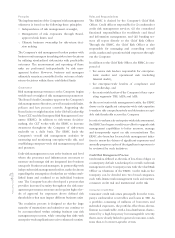American Express 2004 Annual Report Download - page 39
Download and view the complete annual report
Please find page 39 of the 2004 American Express annual report below. You can navigate through the pages in the report by either clicking on the pages listed below, or by using the keyword search tool below to find specific information within the annual report.
Share Repurchases
As discussed previously, the Company has in place a
share repurchase program to return equity capital in
excess of its business needs to shareholders. These
share repurchases are made to both offset the issuance
of new shares as part of employee compensation plans
and to reduce shares outstanding. The Company repur-
chases its common shares primarily by open market
purchases using several brokers at competitive commis-
sion and fee rates. In addition, common shares may also
be purchased from the Company-sponsored Incentive
Savings Program (ISP) to facilitate the ISP’s required dis-
posal of shares when employee-directed activity results
in an excess common share position. Such purchases
are made at market price without commissions or other
fees. During 2004, the Company repurchased 69.4 mil-
lion common shares at an average price of $51.59. Since
the inception of the current share repurchase program,
495.5 million shares have been acquired at an average
price of $29.81 under total authorizations to repurchase
up to 570.0 million shares, including purchases made
under past agreements with third parties. In light of the
Company’s intention to provide additional capital to
AEFC in connection with its plans to pursue a spin-off
of AEFC to the Company’s shareholders, the Company
may modify its share repurchase program during 2005
subject to its capital needs.
Cash Flows
Cash Flows from Operating Activities
For the year ended December 31, 2004, net cash
provided by operating activities was $9.1 billion. The
Company generated net cash from operating activities
in amounts greater than net income during 2004 primar-
ily due to provisions for losses and benefits, which rep-
resent expenses in the Consolidated Statements of
Income but do not require cash at the time of provision.
Similarly, depreciation and amortization represent
non-cash expenses. In addition, net cash was provided
by fluctuations in other operating assets and liabilities.
In the normal course of business, these accounts can
vary significantly due to the amount and timing of
various payments.
Net cash provided by operating activities was lower in
2003 than 2002, as higher net income in 2003 was more
than offset by fluctuations in the Company’s operating
assets and liabilities, primarily reflecting the purchase
of securities in 2002, settled in 2003.
Management believes cash flows from operations,
available cash balances and short-term borrowings
will be sufficient to fund the Company’s operating
liquidity needs.
Cash Flows from Investing Activities
The Company’s investing activities primarily include
funding TRS’ cardmember loans and receivables and
AEFA’s Available-for-Sale investment portfolio.
For the year ended December 31, 2004, net cash used
in investing activities of $11.6 billion decreased from
2003. The decrease reflects the sale of the equipment
leasing product line in TRS’ small business financing
unit and the real estate sale-leaseback transaction (see
Note 10 to the Consolidated Financial Statements) in
2004 as compared to the Threadneedle and Rosenbluth
acquisitions in 2003. This was partially offset by net
increases in cash used for funding cardmember receiv-
ables and loans and contingent liquidity portfolio
investments at TRS and net increases in the investment
portfolio reflecting the cumulative benefit of sales of
annuities, insurance and certificate products at AEFA.
For the year ended December 31, 2003, net cash
used in investing activities increased over 2002 primar-
ily due to an increased investment portfolio and
fewer sales of cardmember receivables and loans to
TRS’ securitization trusts as well as the Threadneedle
and Rosenbluth acquisitions.
Cash Flows from Financing Activities
The Company’s financing activities primarily include
the issuance of debt and AEFA’s sale of annuities and
investment certificates, in addition to taking customer
deposits. The Company also regularly repurchases its
common shares.
Net cash provided by financing activities of $6.2 billion
for the year ended December 31, 2004 rose slightly
compared to 2003, primarily due to a larger net increase
in total debt compared to 2003 offset by a net decrease
in customer deposits in 2004 versus a net increase in
2003 and higher share repurchase activity.
In 2003, financing activities provided net cash greater
than in 2002, primarily due to a net increase in total
debt compared to a net decrease in 2002.
Financing Activities
The Company is committed to maintaining cost-effective,
well-diversified funding programs to support current and
future asset growth in its global businesses. Its funding
plan is structured to meet expected and changing busi-
ness needs to fund asset balances efficiently and cost-
effectively through diversified sources of financing, to
AXP
AR.04
37
Financial Review
























